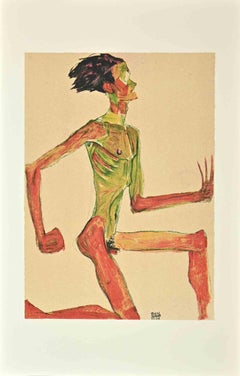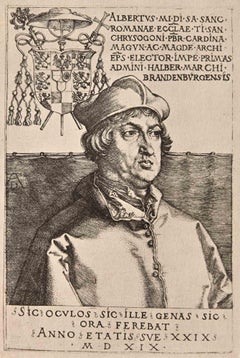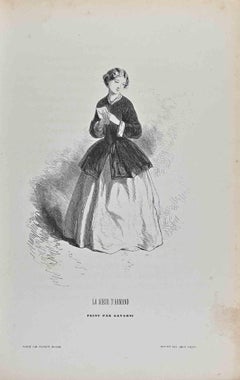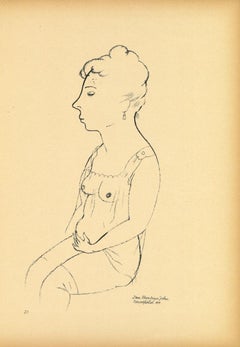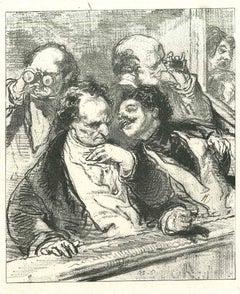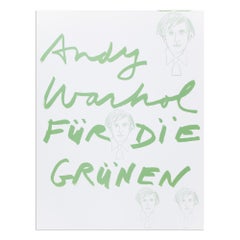Continental Europe - Portrait Prints
to
123
1,388
313
400
111
41
Overall Width
to
Overall Height
to
1,132
381
123
119
69
52
48
37
17
14
5
3
63
35
35
30
29
159
602
1,175
317
17
16
64
40
79
79
164
243
95
53
153
1,785
383
78
1,813
1,033
851
728
708
443
337
303
212
199
142
103
75
54
54
53
44
41
41
37
1,046
623
207
112
97
115
1,329
2,253
4,739
2,833
Item Ships From: Continental Europe
Kneeling Male Nude in Profile - Lithograph - 2007
By Egon Schiele
Located in Roma, IT
Kneeling Male Nude in Profile is a beautifulcolored lithograph from the portfolio " Erotica " after Egon Schiele.
It is a reproduction of the homonym artwork realized in gouache, w...
Category
Early 2000s Modern Continental Europe - Portrait Prints
Materials
Lithograph
Portrait of Cardinal - Woodcut after Albrecht Durer - Early 20th Century
By Albrecht Dürer
Located in Roma, IT
Portrait of Cardinal Albrecht of Brandenburgr is a Woodcut print on cream-colored paper. realized after Albrecht Durer, a reproduction of the early 20th...
Category
Early 20th Century Modern Continental Europe - Portrait Prints
Materials
Woodcut
La Soeur D'Armand - Lithograph By Paul Gavarni - mid 19th century
By Paul Gavarni
Located in Roma, IT
La Soeur D'Armand is a lithograph on ivory-colored paper, realized by the French draftsman Paul Gavarni (alias Guillaume Sulpice Chevalier Gavarni, 1804-1866) in the mid-19th Century...
Category
Mid-19th Century Modern Continental Europe - Portrait Prints
Materials
Lithograph
Louise - Original Lithograph and Offset by George Grosz - 1923
By George Grosz
Located in Roma, IT
Louise is an original offset and lithograph realized by George Grosz.
The artwork is the plate n. 20 from the portfolio Ecce Homo published between 1922/1923, edition of Der Malik-V...
Category
1920s Expressionist Continental Europe - Portrait Prints
Materials
Lithograph, Offset
The Conversation - Original Lithograph by Paul Gavarni - 1881
By Paul Gavarni
Located in Roma, IT
The conversation is an original lithograph on ivory-colored paper, realized by the French draftsman Paul Gavarni (after) (alias Guillaume Sulpice Chevalier Gavarni, 1804-1866) in Par...
Category
1880s Modern Continental Europe - Portrait Prints
Materials
Paper, Lithograph
Andy Warhol, Für die Grünen - Screenprint from 1980, Pop Art
By Andy Warhol
Located in Hamburg, DE
Andy Warhol (1928-1987)
Andy Warhol für die Grünen, 1980
Medium: Screenprint on paper (election poster)
Dimensions: 101 x 77 cm
Edition size unknown: Not signed, not numbered
Publish...
Category
20th Century Pop Art Continental Europe - Portrait Prints
Materials
Screen
Couverture Mourlot IV
By Pablo Picasso
Located in Wien, 9
Pablo Picasso (1881-1973)
Couverture Mourlot IV is the original book cover of the monograph "Picasso. Lithograph". It consist of spine, front and back. Edition 3000, cat. raisonné M...
Category
1960s Modern Continental Europe - Portrait Prints
Materials
Lithograph
The Japanese Tea Ritual - Woodcut print - 1850s
By Utagawa Toyokuni II
Located in Roma, IT
The Japanese tea ritual is a breathtaking ukiyo-e, a original woodblock print on paper, realized at the half of trhe 19th century by the great master, Utagawa Toyokuni II...
Category
1850s Modern Continental Europe - Portrait Prints
Materials
Paper, Woodcut
Portrait - Original Woodcut print by Mino Maccari - Mid-20th Century
By Mino Maccari
Located in Roma, IT
Portrait is an original print realized by Mino Maccari in Mid-20th Century.
Beautiful black and woodcut print on ivory-colored paper. Included a passport: 49 x 34 cm.
Good conditio...
Category
Mid-20th Century Modern Continental Europe - Portrait Prints
Materials
Woodcut
Joan of Austria / - The luminosity of the print -
By Gerard Edelinck
Located in Berlin, DE
Gérard Edelinck (1640 Antwerp - 1707 Paris), Joan of Austria, 1707. Copperplate engraving, 51.2 cm x 29.8 cm, inscribed below the image: "Jeanne d'Autriche Grande Duchesse de Toscane...
Category
Early 1700s Realist Continental Europe - Portrait Prints
Materials
Paper
Luxury Redefined, Richi Rich, Painting, Pop Art, Street Art
By Jay-C
Located in München, BY
Edition 5
Richi Rich keeps toilet paper in his vault.
JAY-C – the pseudonym of this innovative young artist known for his subversive use of familiar figures and symbols. Using a distinct and fine British sense of humour,
he addresses stereotypes of modern society and his work, both playful and profound, stimulates us to question conventional social conceptions. JAY-C is a barometer responding to the world around us.
Having had his first solo exhibition in 2018, in the same year he did a collaboration with BoConcept on their iconic Imola chair...
Category
2010s Pop Art Continental Europe - Portrait Prints
Materials
Mixed Media, Pigment, Archival Pigment
Muhammad Ali vs. Folley, 1967 Photographic print, Dye Sublimation on Aluminum
By Neil Leifer
Located in Los Angeles, CA
Take your place ringside with the indubitable champion of boxing photography, Neil Leifer, as he pays tribute to the legendary Muhammad Ali in an ex...
Category
1960s Continental Europe - Portrait Prints
Materials
Color, Dye Transfer
Portrait of Man with a Pipe - Woodcut print after Utagawa Kuniyoshi
By Utagawa Kuniyoshi
Located in Roma, IT
Portrait of Man with Pipe is a superb color woodblock print on paper, from the Japanese print-series “Taiheiki eiyu den”, 'Tale of Grand Pacification', designed by Utagawa Kuniyoshi ...
Category
1850s Modern Continental Europe - Portrait Prints
Materials
Paper, Woodcut
Portrait of Adolph Menzel - Etching by Giovanni Boldini - 1897
By Giovanni Boldini
Located in Roma, IT
Portrait of Adolph Menzel is a magnificent drypoint realized by Giovanni Boldini in 1897.
Reference:
Buzzoni / M. Toffanello, Museo Giovanni Boldini, G...
Category
1890s Modern Continental Europe - Portrait Prints
Materials
Drypoint, Etching
La Leçon de Musique - Original Etching - 1892
Located in Roma, IT
La Leçon de Musique is an original artwork realized by the French artist George Henri Manesse in 1892. Etching on paper.
Signed on the plate on the lower-left corner; Hand-signed in...
Category
1890s Modern Continental Europe - Portrait Prints
Materials
Etching
Carmen, A Young Girl’s Look - Original Etching (Cramer #52)
By Pablo Picasso
Located in Paris, IDF
Pablo PICASSO
Carmen, A Young Girl’s Look, 1949
Original burin engraving (Atelier Lacourière, Paris)
Unsigned
On Montval wove paper 33 x 26 cm (12.9 x 10.2 in)
REFERENCES :
- Cata...
Category
1940s Modern Continental Europe - Portrait Prints
Materials
Etching
Happy Easter, Street Art, Pop Art, Bugs Bunny
By Jay-C
Located in München, BY
Edition 5
Bugs Bunny is doing a selfportrait painting
JAY-C – the pseudonym of this innovative young artist known for his subversive use of familiar figures and symbols. Using a dis...
Category
2010s Street Art Continental Europe - Portrait Prints
Materials
Mixed Media, Pigment, Archival Pigment
Sailor - Woodcut Print by Lorenzo Viani - 1930 ca.
By Lorenzo Viani
Located in Roma, IT
Sailor is an original xilograph on ivory-colored, realized by the Italian Artist Lorenzo Viani in 1930ca.
Monogram of the artist on the lower left" LV"....
Category
1930s Modern Continental Europe - Portrait Prints
Materials
Woodcut
Arabian Man - Original Etching on Paper by Giacomo Porzano - 1974
By Giacomo Porzano
Located in Roma, IT
Arabian Face is an authentic original colored etching artwork, realized by the Italian artist Giacomo Porzano (1925-2006).
Hand-signed on the lower right in pencil and dated, number...
Category
1970s Contemporary Continental Europe - Portrait Prints
Materials
Paper, Etching
Portrait - Original Charcoal Drawing by Hélène Vogt - 1970s
Located in Roma, IT
Portrait is an original xilography print realized by Hélène Vogt. with the stamp” Atelier Hélène Vogt" On the lower rear.
The state of preservation of the artwork is very good.
Sh...
Category
1970s Continental Europe - Portrait Prints
Materials
Woodcut
Brigitte Bardot - Exhibition Poster
By (After) Kees van Dongen
Located in Collonge Bellerive, Geneve, CH
Kees Van Dongen - Brigitte Bardot - Vintage Exhibition Poster
Vintage Brigitte Bardot, exhibition poster for "Les Peintres Témoins de leur Temps" at G...
Category
1960s Modern Continental Europe - Portrait Prints
Materials
Lithograph
Still Life - Lithograph
By (after) Raoul Dufy
Located in Collonge Bellerive, Geneve, CH
(after) Raoul Dufy
Lithograph after a watercolor, published in the book "Lettre à mon peintre Raoul Dufy." Paris, Librairie Académique Perrin, 1965.
Printed signature
Di...
Category
1940s Fauvist Continental Europe - Portrait Prints
Materials
Lithograph
Portrait of Jules Lenard - Woodcut by Paul Emile Colin - 1907
Located in Roma, IT
Woodcut print realized by Paul Emile Colin in the 1907.
Not signed.
Very good condition.
Category
Early 1900s Modern Continental Europe - Portrait Prints
Materials
Woodcut
Beauty - Original lithograph - 1897
By Edward Burne-Jones
Located in Paris, IDF
Edward Burne-Jones
Beauty, 1898
Original lithograph (Champenois workshop)
Printed signature in the plate
On vellum, 40 x 31 cm (c. 16 x 12 in)
INFORMATION: Lithograph created for t...
Category
1890s Art Nouveau Continental Europe - Portrait Prints
Materials
Lithograph
Salvador Dali - La Fontaine Portrait - Handsigned Engraving
By Salvador Dalí
Located in Collonge Bellerive, Geneve, CH
Salvador Dali - La Fontaine Portrait - Handsigned Engraving
1974
Hand signed by Dali
Edition: /250
The dimensions of the image are 22.8 x 15.7 inches on 31 x 23.2 inch paper
Referenc...
Category
1970s Surrealist Continental Europe - Portrait Prints
Materials
Drypoint, Aquatint
" Orphée à la lyre " Orpheus' Obsession Myth
By Jean Cocteau
Located in CANNES, FR
Jean Cocteau ( 1889 -1963 )
" Orphée à la lyre "
signed and dated jean Cocteau 1958 .
marked and numbered (10/50) Edition originale de Jean Cocteau Atelier Madeline-Jolly 10/50 (u...
Category
1950s Art Deco Continental Europe - Portrait Prints
Materials
Ceramic
Théo Tobiasse - A train - Original Lithograph
By Théo Tobiasse
Located in Collonge Bellerive, Geneve, CH
Théo Tobiasse
Title: C'est un train portant un parfum d'odalisque
Signed and Numbered
Dimensions: 57 x 76 cm
Information : Edition of 175
Condition : E...
Category
1980s Surrealist Continental Europe - Portrait Prints
Materials
Lithograph
Salvador Dali - Don Quixote Pear - Original Hand-Signed Lithograph
By Salvador Dalí
Located in Collonge Bellerive, Geneve, CH
Salvador Dali - Don Quixote Pear - Original Hand-Signed Lithograph
1969
Dimensions: P. 57 x 37 cm
Sheet: 75 x 56 cm
Handsigned, EA (Epreuve d'Artiste)
Excellent Condition
Reference:...
Category
1960s Surrealist Continental Europe - Portrait Prints
Materials
Lithograph
BOAC Speedbird Routes Across the World – Original Vintage British Airline Poster
By Harold Foster
Located in Zurich, CH
Original Vintage Airline Poster by Harold Foster. He created several designs commissioned by the British Overseas Airways Corporation ...
Category
Mid-20th Century Continental Europe - Portrait Prints
Materials
Paper
Leonor Fini, rare lithograph on Arches paper, circa 1980
By Leonor Fini
Located in Saint Ouen, FR
Rare print handsigned by surrealist artist Leonor Fini, inscreasingly esteemed with the movement of rediscovering art by women. This rare original lithograph is an artist proof in ve...
Category
Mid-20th Century Surrealist Continental Europe - Portrait Prints
Materials
Paper
Triptych Edition 4/25. Contemporary Portraits With Moldovan Carpet Floral Motifs
By Natasha Lelenco
Located in FISTERRA, ES
This limited-edition triptych (Edition 4 of 25) forms part of The Dinners, a key series within the artist’s ongoing Moldovan Carpet project. The work reflects on how domestic rituals...
Category
2010s Pop Art Continental Europe - Portrait Prints
Materials
Metal
Salvador Dali - Raspberry - Original Hand-Signed Lithograph
By Salvador Dalí
Located in Collonge Bellerive, Geneve, CH
Salvador Dali - Raspberry - Original Hand-Signed Lithograph
1969
Dimensions: P. 57 x 37 cm
Sheet: 75 x 56 cm
Handsigned, EA (Epreuve d'Artiste)
Excellent Condition
Reference: Field...
Category
1960s Surrealist Continental Europe - Portrait Prints
Materials
Lithograph
Corto Maltese : PARIS - Original Screenprint Ltd /500
Located in Paris, IDF
Hugo PRATT (1927-1995)
🎨 Corto Maltese "PARIS"
🖨 Original print from an original drawing of Hugo Pratt
🖋 Signed in the plate + embossed seal + official stamp on back
📏 On Innov...
Category
21st Century and Contemporary Modern Continental Europe - Portrait Prints
Materials
Screen
‘The Mouth That Roared, 1970’, Photographic Print, Dye Sublimation on Aluminum
By Neil Leifer
Located in Los Angeles, CA
Homage to Ali: Neil Leifer pays tribute to the legendary Muhammad Ali in an exclusive set of classic photographs.
The Mouth That Roared, Miami Beach, October 9, 1970: “It was imposs...
Category
1970s Continental Europe - Portrait Prints
Materials
Dye Transfer
Pablo Picasso - The Painter and His Model - Original Lithograph
By Pablo Picasso
Located in Collonge Bellerive, Geneve, CH
Original Lithograph - Pablo Picasso
Title: The Painter and His Model
This is unsigned and unnumbered, as issued
From the book/portfolio "Regards sur Paris"
Published by André Saure...
Category
1960s Modern Continental Europe - Portrait Prints
Materials
Lithograph
Chris Levine - EQUANIMITY_2022 20 Limited Queen Elizabeth II Photography Modern
By Chris Levine
Located in Madrid, Madrid
Chris Levine EQUANIMITY_2022 20
Date of creation: 2022
Medium: Screenprint on Somerset Satin paper
Edition number: 3/5
Size: 47 x 38 cm
Condition: New in mint conditions, never frame...
Category
2010s Conceptual Continental Europe - Portrait Prints
Materials
Satin Paper, Screen
Salvador Dali - The Vision - Original Lithograph
By Salvador Dalí
Located in Collonge Bellerive, Geneve, CH
Salvador Dali - The Vision - Original Lithograph
Joseph FORET, Paris, 1957
PRINTER : Detruit.
SIGNATURE : plate signed by Dali.
LIMITED : 233 copies.
SIZE : 41 x 33 cm
REFERENCES ...
Category
1950s Surrealist Continental Europe - Portrait Prints
Materials
Lithograph
Leonor Fini, rare lithograph on Arches paper, circa 1980
By Leonor Fini
Located in Saint Ouen, FR
Rare print handsigned by surrealist artist Leonor Fini, inscreasingly esteemed with the movement of rediscovering art by women. This rare original lithograph is an artist proof in ve...
Category
Mid-20th Century Surrealist Continental Europe - Portrait Prints
Materials
Paper
Jean Cocteau - White Book - Original Handcolored Lithograph
By Jean Cocteau
Located in Collonge Bellerive, Geneve, CH
Jean Cocteau
White Book - Autobiography about Cocteau's discovery of his homosexuality. The book was first published anonymously and created a scandal.
Original Handcolored Lithograp...
Category
1930s Modern Continental Europe - Portrait Prints
Materials
Lithograph
after Henri Matisse, "Sitting Blue Nude"
By Henri Matisse
Located in Collonge Bellerive, Geneve, CH
Lithograph after Henri Matisse - Sitting Blue Nude
Artist : after Henri MATISSE
Edition of 200
76 x 56 cm
With stamp of the Succession Matisse
References : Artvalue - Succession Ma...
Category
1950s Modern Continental Europe - Portrait Prints
Materials
Lithograph
Portrait of Roby - Etching (Bloch #680)
By Pablo Picasso
Located in Paris, IDF
Pablo PICASSO (after)
Portrait of Roby, c. 1950
Restrike etching
Printed signature in the plate
On Japan paper 33 x 25 cm (c. 13 x 10 in)
REFERENCE : Catalog raisonne Bloch #680
Fr...
Category
Mid-20th Century Modern Continental Europe - Portrait Prints
Materials
Etching
Andy Warhol, The Star - Kestner-Gesellschaft, Exhibition Poster, Pop Art Print
By (after) Andy Warhol
Located in Hamburg, DE
After Andy Warhol (1928-1987)
Andy Warhol, Kestner-Gesellschaft, Exhibition Poster, 1981
Medium: Offset lithograph in colors on paper
Dimensions: 84 x 59 cm
Category
20th Century Pop Art Continental Europe - Portrait Prints
Materials
Offset
Jean Cocteau - Juliet Waiting for Romeo - Original Lithograph
By Jean Cocteau
Located in Collonge Bellerive, Geneve, CH
Original Lithograph by Jean Cocteau
From "Théâtre" Portfolio, 1957
Edition: 207 / 8800
Dimensions: 22.5 x 15.5 cm
Jean Cocteau
Writer, artist and film director Jean Cocteau was on...
Category
1950s Modern Continental Europe - Portrait Prints
Materials
Lithograph
The Accordion Player - Lithograph by Enrico Benaglia - 1980s
By Enrico Benaglia
Located in Roma, IT
Color lithograph on wove paper realized by Enrico Benaglia in 1980s.
Edition of 99.
Hand signed and numbered in pencil.
This imaginative lithograph by Enrico Benaglia exudes both ...
Category
1980s Contemporary Continental Europe - Portrait Prints
Materials
Lithograph
Portrait of a Girl - Lithograph by Enrico Benaglia - 1980s
By Enrico Benaglia
Located in Roma, IT
Colored lithograph on wove paper realized by Enrico Benaglia in 1980s.
Edition of 130.
Hand signed and numbered in pencil.
Very good condition.
This expressive lithograph by Enri...
Category
1980s Contemporary Continental Europe - Portrait Prints
Materials
Lithograph
Girl - Etching by Giovan Battista De Andreis - 1980s
Located in Roma, IT
Etching realized in the early 1980s.
Hand signed and numbered.
Edition of 30.
Very good condition.
Category
1980s Contemporary Continental Europe - Portrait Prints
Materials
Etching
Umbrella Girl - Lithograph by Paola Grott - 1990s
Located in Roma, IT
Lithograph realized by Paola Grott in 1990s.
Hand signed and numbered and hand colored.
Edition of 50.
Very good condition.
Category
1990s Contemporary Continental Europe - Portrait Prints
Materials
Lithograph
Erotic Scene - Etching by Chas Laborde - 1920s
By Chas Laborde
Located in Roma, IT
Erotic is an etching by Chas Laborde in the 1920s. This original print is hand-colored in watercolor.
In very good condition, including white cardboard Passepartout, 52 x 37cm.
This artwork belongs to the erotic series of Chas Laborde in which you recognize his authentic style of illustration.
Chas Laborde (Buenos Aires, 1886 - Paris, 1941)
Charles Laborde...
Category
1920s Continental Europe - Portrait Prints
Materials
Etching
Shy Red Hair Woman - Lithograph
By Paul César Helleu
Located in Paris, IDF
Paul César Helleu
Shy Red Hair Woman, 1913
Lithograph and watercolor stencil
Printed signature
On vellum 26 x 20 cm (c. 10.5 x 8 inch)
Very good condition
Category
1890s Art Nouveau Continental Europe - Portrait Prints
Materials
Lithograph
Shibuya- 21st Century, Contemporary, Japanese Woman Portrait, Pigment Print
By Ger Doornink
Located in Barcelona, Catalonia
Edition of 50
Ger Doornink's limited editions are based on a high resolution scan of the original artwork. They are printed on archival Hahnemühle German Etching paper. This techniq...
Category
21st Century and Contemporary Contemporary Continental Europe - Portrait Prints
Materials
Archival Paper, Etching
Musical Instrument - Lithograph - 1862
Located in Roma, IT
Musical Instrument is a lithograph on paper realized in 1862.
Titled on the lower.
The artwork belongs to the Suite Uses and customs of all the peoples of the universe: " History o...
Category
1860s Modern Continental Europe - Portrait Prints
Materials
Lithograph
Portrait of a Girl - Lithograph by Enrico Benaglia - 1980s
By Enrico Benaglia
Located in Roma, IT
Colored lithograph on wove paper realized by Enrico Benaglia in 1980s.
Edition of 130.
Hand signed and numbered in pencil.
Very good condition.
This expressive lithograph by Enri...
Category
1980s Contemporary Continental Europe - Portrait Prints
Materials
Lithograph
Anne Collier, Woman Crying - Contemporary Art, Women Artist, Signed Print
By Anne Collier
Located in Hamburg, DE
Anne Collier (American, b. 1970)
Woman Crying, 2020
Medium: Ditone print on paper
Dimensions: 37.1 x 45 cm (14.6 x 17.7 in)
Edition of 100: Hand-signed and numbered
Condition: Mint
Category
21st Century and Contemporary Contemporary Continental Europe - Portrait Prints
Materials
Digital Pigment
Portrait - Lithograph by Armando De Stefano - 1981
By Armando De Stefano
Located in Roma, IT
Screen print realized in 1981
Hand signed and numbered in pencil.
Edition of 150.
Very good condition.
Category
1980s Contemporary Continental Europe - Portrait Prints
Materials
Lithograph
Renaissance Woman - Lithograph by Alessandro Kokocinski - 1990s
Located in Roma, IT
Lithograph on paper realized by Alessandro Kokocinski.
Hand signed in pencil.
Excellent condition.
Category
1990s Contemporary Continental Europe - Portrait Prints
Materials
Lithograph
General Wilhelm von Blume - Visionary retrospective -
Located in Berlin, DE
Bernhard Pankok (1872 Münster - 1943 Baierbrunn), General Wilhelm von Blume, 1915, aquatint etching, 34 x 29.5 cm (sheet size), 26 x 22 cm (plate size), signed in the plate at upper left, in pencil at lower right and dated in pencil at lower left.
- At lower left old collection stamp, at the right broad margin with a small spot, otherwise very good condition.
About the artwork
The 1915 aquatint etching of General Wilhelm von Blume is based on a 1912 oil painting in the LWL-Museum für Kunst und Kultur in Münster. A second oil portrait of the general by Pankok is in the Staatsgalerie Stuttgart. When Pankok painted the first oil portrait in 1912, the general had already been retired for 16 years. It is therefore a retrospective portrait. Accordingly, the orientation of his head is such that he is looking back in both the oil painting and the etching. Without fixing on anything in particular, he looks thoughtfully inwards and reflects on his life. Uniformed and highly endowed, it is his military activities in particular that he is reviewing attentively and, as his gaze reveals, quite critically.
Pankok has literally written the sum of his experiences on Wilhelm von Blume's face: The physiognomy is a veritable landscape of folds, furrows, ridges and gullies, all the more striking against the flat background. It is clear that each of the medals was also won through suffering. However, by breaking the boundaries of the picture, his bust appears as an unshakable massif, which gives the general a stoic quality.
The fact that the design of the portrait was important to Pankok can be seen from the different versions, the present sheet being the third and probably final revision, which Pankok dates precisely to 18 February 1915. Compared with the previous state, the light background now has a dark area against which the sitter's face stands out, the dark background in turn combining with the uniform to create a new tension in the picture.
Pankok's taking up of the portrait of the high-ranking military veteran and its graphic reproduction can also be seen in relation to the First World War, which had broken out in the meantime. In the face of modern weapons of mass destruction, Wilhelm von Blume's warfare and military writings were relics of a bygone, more value-oriented era.
About the artist
After studying at the Düsseldorf Art Academy from 1889 to 1891 under Heinrich Lauenstein, Adolf Schill, Hugo Crola, and Peter Janssen the Elder, Bernhard Pankok went to Munich in 1892, where he worked primarily as a graphic artist for the two major Jugendstil magazines "Pan" and "Jugend," which established his artistic success. Through this work he met Emil Orlik, with whom he had a lifelong friendship.
In 1897, he exhibited his first furniture, and in 1898, together with Richard Riemerschmid, Bruno Paul and Hermann Obrist...
Category
1910s Realist Continental Europe - Portrait Prints
Materials
Etching
"PLACEBO.5" Portrait Pop Art Plexiglass Print 39' x 28' inch by Edyta Grzyb
By Edyta Grzyb
Located in Culver City, CA
"PLACEBO.5" Portrait Pop Art Plexiglass Print 39' x 28' inch by Edyta Grzyb
Fine art pigment print on Hahnemühle, 300 g under acrylic glass
2025
Edition of 50
Each print is signed o...
Category
21st Century and Contemporary Pop Art Continental Europe - Portrait Prints
Materials
Plexiglass, Pigment
After Andy Warhol, Russel Means (American Indian) - Signed Exhibition Poster
By Andy Warhol
Located in Hamburg, DE
After Andy Warhol (1928-1987)
Russell Means (American Indian), 1979
Medium: Offset lithograph on paper (exhibition poster)
Dimensions: 33 x 23 1/4 inches (84 x 59 cm)
Publisher: Gal...
Category
20th Century Pop Art Continental Europe - Portrait Prints
Materials
Offset
Murat - Etching by Emile Giroua - 1837
Located in Roma, IT
Murat is an original Etching realized by Emile Giroua in 1837.
Good conditions.
The artwork is realized in a well-balanced composition. the artwork and belongs to the suite suite "...
Category
1830s Modern Continental Europe - Portrait Prints
Materials
Etching
Soult - Etching by Pierre François Tardieu - 1837
Located in Roma, IT
Soult is an Etching realized in 1837 by Pierre François Tardieu.
Good conditions.
The artwork is realized in a well-balanced composition. the artwork and belongs to the suite suite...
Category
1830s Modern Continental Europe - Portrait Prints
Materials
Etching
